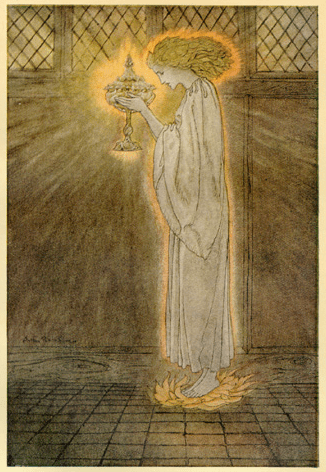
Most versions of the stories report that Lancelot has a son called Galahad with a woman named Elaine of Corbenic. The father of Elaine of Corbenic is King Pelles, sometimes called the Fisher King, who is the guardian of the Holy Grail. Legend has it that Pelles is descended from one Bron, a follower of Joseph of Arimathea, who brought the Grail to Britain. Bron is also thought to be derived in part from the character of Bran the Blessed in the Welsh Mabinogian. Bran possessed a magic cauldron that could resurrect the dead. Bran and his cauldron bring to mind the North, from the name itself to the resurrected dead of from beyond the Wall.
Additionally, there is a detail in the etymology of Corbenic which I believe ties Corbenic, Elaine and the Fisher King very closely to the Starks. There are a number of possible linguistic connections, among them the Brythonic Caer Bran (literally Fort of Bran, or Fort of the Raven) and the middle French corbin, also meaning Raven, thought by many to be an allusion to Bran the Blessed with whom the Fisher King is closely connected. We’ll get to the larger connection between Pelles, Bran the Blessed and the Starks shortly. But given all of the above, I would assume a Stark connection for the character of Elaine.
In Le Morte d’Arthur, Thomas Malory describes Elaine as “passing fair and young.” Compare that to Eddard Stark’s memory of his sister “Lyanna had only been sixteen, a child woman of surpassing loveliness.” After Lancelot rescues Elaine from a “scalding bath” she falls in love with him. If we apply this to Lyanna, we might wonder again if she could have been in trouble with a fiery minded Targaryen. Getting back to the idea of a rescue in the Lyanna and Rhaegar story, isn’t it curious that this theme appears again in the story of Elaine of Corbenic and Lancelot?
In this version of the tale though, Elaine must ultimately resort to a magical disguise to trick Lancelot into lying with her and conceiving Galahad. I propose that, with typical Martinism, the analogy is now given a different twist, but one that remains centered on the Tourney at Harrenhal and Lyanna’s actions there.
Lancelot, it turns out, is closely connected with a traditional folk story that has three main elements: a child raised by a water sidhe, the appearance of a hero at a tournament on three consecutive days in three different disguises, and the rescue of a kidnapped queen.
If we assume that Lyanna Stark is the KotLT and also analogous to Elaine of Corbenic with her Stark connections, we see that both are associated with disguises. As it happens, the disguise Elaine assumes for Lancelot is of Gwenhwyfar.
Now, if we assign the role of sidhe child, with its close association with water, to the “little crannogman” at the tourney and agree that Lyanna’s disguise as the KotLT and defeat of three champions satisfies the second element we have two of the elements of the original topos present. Is it possible to see Lyanna as also fulfilling the role of the captive queen of the third element? Since we’ve already proposed that Lyanna is analogous with Gwenhwyfar in one version of the rescue story, and given that Elaine assumed Gwenhwyfar’s identity to conceive Galahad we might now stop to consider if the young man widely assumed to be Lyanna’s son has any similarities with Galahad.